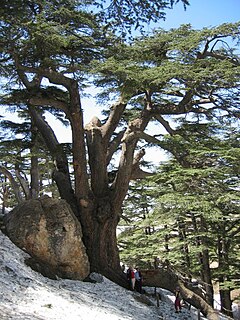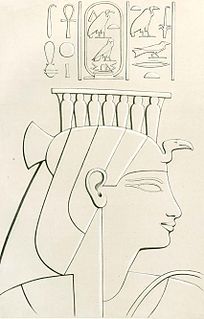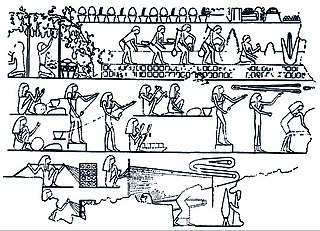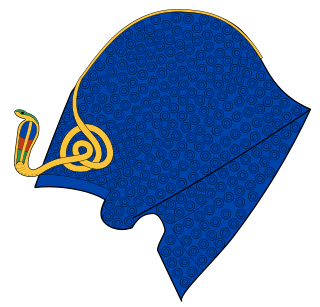Description
The large Egyptian vessel, built by the pharaoh Sneferu, was about 100 cubits (just over 50 m) long and made of cedar wood. [2] Ancient Egypt was treeless, generally speaking, and domestic wood was very rare. The earliest boats on the Nile were assembled of bundled reeds lashed together, the two sḥn ("armloads") of the Pyramid Texts. [3] The earliest written record of international trade of timber is from the Palermo Stone where Sneferu imports cedar from Phoenicia (now Lebanon), Bringing forty ships filled [with] cedar logs. Shipbuilding [of] cedar wood, one ship, 100 cubits [long]... [4]

Pharaoh is the common title of the monarchs of ancient Egypt from the First Dynasty until the annexation of Egypt by the Roman Empire in 30 BCE, although the actual term "Pharaoh" was not used contemporaneously for a ruler until Merneptah, c. 1200 BCE. In the early dynasty, ancient Egyptian kings used to have up to three titles, the Horus, the Sedge and Bee (nswt-bjtj) name, and the Two Ladies (nbtj) name. The Golden Horus and nomen and prenomen titles were later added.

The cubit is an ancient unit of length that had several definitions according to each of the various different cultures that used the unit. These definitions ranged between 444 and 529.2 mm. The unit was based on the forearm length from the tip of the middle finger to the bottom of the elbow. Cubits of various lengths were employed in many parts of the world in antiquity, during the Middle Ages and as recently as Early Modern Times. The term is still used in hedgelaying, the length of the forearm being frequently used to determine the interval between stakes placed within the hedge.

Cedrus libani, commonly known as the cedar of Lebanon or Lebanon cedar, is a species of cedar native to the mountains of the Eastern Mediterranean basin. It is an evergreen conifer that can reach 40 m (130 ft) in height. It is the national emblem of Lebanon and is widely used as an ornamental tree in parks and gardens.
During ancient times, "name devices" for ships typically were of gods/goddesses of the city in which it came from or the name of the guardian deity. Typically called a parasemon or episemon, it was the ship's name and often indicated the hope for good luck at sea. [5]
Many times an ancient Egyptian ship was named after the pharaoh and one of his virtues. For example, the ship of Amenhotep II, who reigned 1427 BCE to 1400 BCE, was called, Amenhotep II who made strong the Two Lands. [6] This ship was built some 1200 years after Sneferu's, Praise of the Two Lands, which is the earliest known ship name. [7] [8] The "Two Lands" referred to here are Upper Egypt upriver and Lower Egypt at the delta. [9] The name of Sneferu's ship Praise of the Two Lands had political implications as the name is believed to have signified the unity between the lands of Upper and Lower Egypt. [10] [11]

Amenhotep II was the seventh Pharaoh of the 18th dynasty of Egypt. Amenhotep inherited a vast kingdom from his father Thutmose III, and held it by means of a few military campaigns in Syria; however, he fought much less than his father, and his reign saw the effective cessation of hostilities between Egypt and Mitanni, the major kingdoms vying for power in Syria. His reign is usually dated from 1427 to 1401 BC.

Upper Egypt is the strip of land on both sides of the Nile that extends between Nubia and downriver (northwards) to Lower Egypt.

Lower Egypt is the northernmost region of Egypt: the fertile Nile Delta, between Upper Egypt and the Mediterranean Sea — from El Aiyat, south of modern-day Cairo, and Dahshur. Historically, the Nile River split into seven branches of the delta in Lower Egypt. Lower Egypt was divided into nomes and began to advance as a civilization after 3600 BC. Today, it contains two channels major that flow through the delta of the Nile River.
It is not known if the name of the ship (i.e. Praise of the Two Lands) was put on its side as is done today so others could see the letters. It is likely that a bold mark was used instead since there were no telescopes that could be used from shore or another ship. The special mark would be the means of identification. [12]

A telescope is an optical instrument that makes distant objects appear magnified by using an arrangement of lenses or curved mirrors and lenses, or various devices used to observe distant objects by their emission, absorption, or reflection of electromagnetic radiation. The first known practical telescopes were refracting telescopes invented in the Netherlands at the beginning of the 17th century, by using glass lenses. They were used for both terrestrial applications and astronomy.
In Egyptian history, the Upper and Lower Egypt period was the final stage of prehistoric Egypt and directly preceded the nation's unification. The conception of Egypt as the Two Lands was an example of the dualism in ancient Egyptian culture and appeared frequently in texts and imagery, including in the titles of Egyptian pharaohs.

Amenhotep III, also known as Amenhotep the Magnificent, was the ninth pharaoh of the Eighteenth Dynasty. According to different authors, he ruled Egypt from June 1386 to 1349 BC, or from June 1388 BC to December 1351 BC/1350 BC, after his father Thutmose IV died. Amenhotep III was Thutmose's son by a minor wife, Mutemwiya.
The First Dynasty of ancient Egypt covers the first series of Egyptian kings to rule over a unified Egypt. It immediately follows the unification of Upper and Lower Egypt, possibly by Narmer, and marks the beginning of the Early Dynastic Period, a time at which power was centered at Thinis.

The history of ancient Egypt spans the period from the early prehistoric settlements of the northern Nile valley to the Roman conquest, in 30 BC. The Pharaonic Period is dated from the 32nd century BC, when Upper and Lower Egypt were unified, until the country fell under Macedonian rule, in 332 BC.

The Bent Pyramid is an ancient Egyptian pyramid located at the royal necropolis of Dahshur, approximately 40 kilometres south of Cairo, built under the Old Kingdom Pharaoh Sneferu. A unique example of early pyramid development in Egypt, this was the second pyramid built by Sneferu.

Maathorneferure was an Ancient Egyptian queen, the Great Royal Wife of Ramesses II.

The majority of Egyptologists agree on the outline and many details of the chronology of Ancient Egypt. This scholarly consensus is the so-called Conventional Egyptian chronology, which places the beginning of the Old Kingdom in the 27th century BC, the beginning of the Middle Kingdom in the 21st century BC and the beginning of the New Kingdom in the mid-16th century BC.

Great Royal Wife, or alternatively, Chief King's Wife, is the term that was used to refer to the principal wife of the pharaoh of Ancient Egypt, who served many official functions.

Ahmose-Meritamun was a Queen of Egypt during the early Eighteenth dynasty of Egypt. She was both the sister and the wife of Pharaoh Amenhotep I. She died fairly young and was buried in tomb TT358 in Deir el-Bahari.

Mutemwiya was a minor wife of Thutmose IV, a pharaoh of Egypt, in the Eighteenth Dynasty and the mother of Pharaoh Amenhotep III. Mutemwiya's name means "Mut in the divine bark".
The Tessarakonteres, or simply "forty" was a very large catamaran galley reportedly built in the Hellenistic period by Ptolemy IV Philopator of Egypt. It was described by a number of ancient sources, including a lost work by Callixenus of Rhodes and surviving texts by Athenaeus and Plutarch. According to these descriptions, supported by modern research by Lionel Casson, the enormous size of the vessel made it impractical and it was built only as a prestige vessel, rather than an effective warship. The name "forty" refers not to the number of oars, but to the number of rowers on each column of oars that propelled it, and at the size described it would have been the largest ship constructed in antiquity, and probably the largest human-powered vessel ever built.

Ancient Egyptian technology describes devices and technologies invented or used in Ancient Egypt. The Egyptians invented and used many simple machines, such as the ramp and the lever, to aid construction processes. They used rope trusses to stiffen the beam of ships. Egyptian paper, made from papyrus, and pottery were mass-produced and exported throughout the Mediterranean basin. The wheel was used for a number of purposes, but chariots only came into use after the Second Intermediate period. The Egyptians also played an important role in developing Mediterranean maritime technology including ships and lighthouses.

The khepresh was an ancient Egyptian royal headdress. It is also known as the blue crown or war crown. New Kingdom pharaohs are often depicted wearing it in battle, but it was also frequently worn in ceremonies. It used to be called a war crown by many, but modern historians refrain from defining it thus.

Scarabs were popular amulets and impression seals in Ancient Egypt. They survive in large numbers and, through their inscriptions and typology, they are an important source of information for archaeologists and historians of the ancient world. They also represent a significant body of ancient art.
The Instructions of Kagemni is an ancient Egyptian instructional text of wisdom literature which belongs to the sebayt ('teaching') genre. Although the earliest evidence of its compilation dates to the Middle Kingdom of Egypt, its authorship has traditionally yet dubiously been attributed to Kagemni, a vizier who served during the reign of the Pharaoh Sneferu (r. 2613–2589 BC), founder of the fourth dynasty of Egypt.
Ranefer was a prince of ancient Egypt during the 4th dynasty. His name means “Ra is beautiful”.
The High Priest of Ra or of Re was known in Egyptian as the wr-mꜢw, which translates as Greatest of Seers.
Djadjaemankh is the name of a fictitious ancient Egyptian magician appearing in the third chapter of a story told in the legendary Westcar Papyrus. He is said to have worked wonders during the reign of king (pharaoh) Sneferu.




















